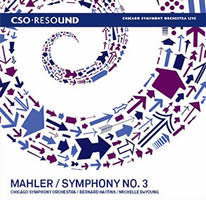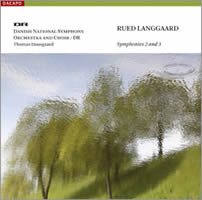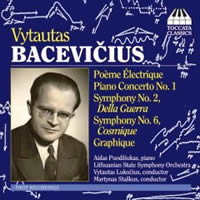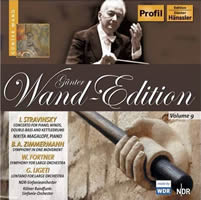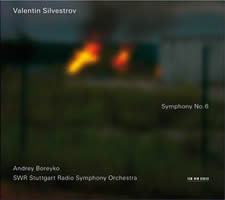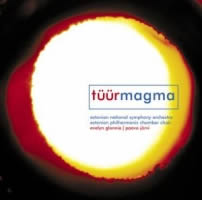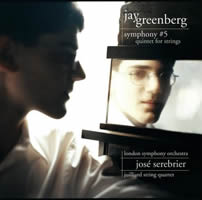Mostly Symphonies 5.
|
Grant Chu Covell [October 2007.]
Gustav MAHLER: Symphony No. 3 (1895-96). Michelle DeYoung (mez-sop), Chicago Symphony Orchestra, Women of the Chicago Symphony Chorus, Chicago Children’s Choir, Bernard Haitink (cond.). CSO Resound CSOR 901 701, 2CDs (http://cso.org/). Distributed in the US by Harmonia Mundi (http://www.harmoniamundi.com/). This auspicious recording, the first on the CSO’s own label, is a keeper to shelve near Horenstein’s beloved Third. At 1:41:25 here, the Third is perhaps the Mahlerphile’s most indulgent banquet. While the “thousand-man” Eighth has a plot, the Third ardently strolls across romanticized nature motifs. Consider Mahler’s first four as a super-symphony: the dawning “Titan” as sonata-allegro, the “Resurrection” as a weighty, emotional slow movement, the Third as the ebullient scherzo and the Fourth with its third movement’s variations and concluding rondo — originally the Third’s goal — as the delicate finale. Infused with Des Knaben Wunderhorn settings, Mahler’s tetralogy extends the German lied tradition, the bucolic Third channeling a hyper-Schubert. It may take the neutrality of Laurence Equilbey’s a cappella group Accentus’ second release, “Transcriptions 2” (Naïve V 5048), to hear the short distance between Schubert and Mahler, admittedly emphasized by transcriber Clytus Gottwald. If Schubert had lived past 31, he might have written “What the Angels Tell Me.” Haitink crafts a precision Third, neatly arraying music and instruments; however, the taut tempos could have profited from modest recklessness, especially in the third movement’s quasi-scherzo.
Rued LANGGAARD: Symphony No. 2, “Awakening of Spring” (orig. vers. 1912-14); Symphony No. 3, “The Flush of Youth — La Melodia” (1915-16, rev. 1925-33). Inger Dam-Jensen (sop), Per Salo (pno), Danish National Symphony Orchestra and Choir / DR, Thomas Dausgaard (cond.). Dacapo 6.220516, SACD format (http://www.dacapo-records.dk/). Distributed in the US by Naxos (http://www.naxos.com/). “Orchestral Music.” Carl NIELSEN: Var. comps. Danish National Symphony Orchestra / DR, Thomas Dausgaard (cond.). Dacapo 6.220518, SACD format (http://www.dacapo-records.dk/). Distributed in the US by Naxos (http://www.naxos.com/). Flush with Straussian bravado, Langgaard’s Second erupts joyously. The three movements weave contemplatively through broad-shouldered Romanticism. One suspects its composer was following a hidden program, given the digressions and loose structure. The soprano voice appears in the final movement, where Emil Rittershaus’ Spring Sounds soar over the orchestra. Later in life, Langgaard grew increasingly isolated and resentful as his music was passed over. A pathological hatred of Nielsen grew all-consuming and he eventually withdrew into a bizarre, anachronistic Romantic style. His chronic desire to revise did not help matters. Many works exist in multiple versions (two different Fifths are on Dacapo 8.224215). However, the Third exists only in its final form, essentially a piano concerto whittled down from a larger effort. Schumann’s ghost pulls the strings, and there’s a bittersweet, almost manic twinge to the proceedings. The piano inserts tiny sunbursts into the predominantly funereal central movement which leads to the febrile finale including a wordless chorus. Never tedious, always unexpected, this remarkably individual music is worth getting to know. Dausgaard works wonders with the Danish National Symphony, definitely a pairing to watch. Based on this luminescent assortment of Nielsen recordings, we should hope that Dacapo has the six symphonies in preparation. Perhaps the home-court advantage contributes to the delightful lilt and sublime balance. Alongside the familiar orchestral pieces, Pan and Syrinx, Cupid and the Poet, A Fantasy Journey to the Faroe Islands and bits from the operas Masquerade and Saul and David, are lesser known cuttings from the stage plays Sir Oluf, Snefrid and Willemoes. I learned from the notes that the Danish Broadcasting Corporation airs Nielsen’s Helios Overture every New Year, a perfect conclusion for this release.
Vytautas BACEVICIUS: Poème Électrique, Op. 16 (1932); Concerto for Piano and Orchestra No. 1, “Sur les thèmes lituaniens,” Op. 12 (1929); Symphony No. 2, “Della Guerra,” Op. 32 (1940); Symphony No. 6, “Cosmique,” Op. 66 (1960); Graphique, Op. 68 (1964). Aidas Puodziukas (pno), Lithuanian State Symphony Orchestra, Vytautas Lukocius (cond.), Martynas Staskus (cond.). Toccata Classics TOCC 0049 (http://www.toccataclassics.com/). Distributed in the US by Allegro (http://www.allegro-music.com/). Toccata offers a heady sampler of Bacevicius’ robust orchestral music. Definitely less familiar than his sister Grazyna Bacewicz’s compositions, these works arc from Expressionism towards bracing atonality. As if Berg or Scriabin had played big-city piano bars, the first piano concerto sashays through vivacious tonality. Its Lithuanian themes, rarely surfacing untouched, contribute exotic flavors. The steel-toed Poème électrique girds Bartók’s gnarled expressionist flair with the propulsive force of other machine-age works, such as Honegger’s Pacific 231 (1923) and Mosolov’s Iron Factory (1927). There’s also a kinship to the abrasive gyrations of Roussel’s Third as well as Prokofiev’s (1930 and 1928). Concertizing and consequently stranded in South America when WWII began, Bacevicius wrote his “of the war” symphony in Argentina, identifying programmatic images: Germany invading Poland, funerals, the Western front, etc. Believing he had to constrain his style to align with conservative times and his newfound American residency, this less caustic and dissonant music is constructed fairly monothematically in bold, primary colors with shades of Vaughan Williams and premonitions of William Schuman. Towards the end of his life Bacevicius (1905-70) returned to his avant-garde nature. The Sixth and Graphique invoke Varèse’s spirit with fragmentary motives, abandonment of traditional forms and hunger for new colors and contrasts. As its title implies, in Graphique Bacevicius tackled his material visually. The booklet includes Bacevicius’ single-page graphic realization alongside the score’s first conventionally notated page. These are first recordings and, we hope, the start of a series.
“Günter Wand-Edition. Volume 9.” Igor STRAVINSKY: Concerto for Piano, Winds, Double-Bass and Kettledrums (1923/24, rev. 1930); Bernd Alois ZIMMERMANN: Symphony (1951, rev. 1953); Wolfgang FORTNER: Symphony (1947); György LIGETI: Lontano (1967). Nikita Magaloff (pno), NDR Sinfonieorchester; Kölner Rundfunk-Sinfonie-Orchester [WDR Sinfonieorchester Köln], Günter Wand (cond.). Profil PH05042 (http://www.haensslerprofil.de/). Distributed in the US by Naxos (http://www.naxos.com/). In four movements, Fortner’s symphony cuts a traditional shape despite acerbic and martial tonality. Surviving WWII, Fortner didn’t follow Strauss through verdant Romanticism. His Symphony upholds an angular style bristling with energy and nervous rhythms. The briefest scherzo seems to distort a polka. Like many who passed through Darmstadt and Freiburg, Zimmermann was a Fortner student. His single-movement Symphony shreds black moods with fierce outbursts. It’s hard not to hear the compact work as a manic plea knowing he would eventually take his life. Ligeti’s Lontano ignores serial manipulations for a structured exploration of color and texture. In all these pieces, Wand applies a Romantic glow which works well for the symphonies, but not for Lontano which requires a surgical approach (take Abbado and the Wiener Philharmoniker on DG 429 260-2 or Nott and the Berliner Philharmoniker on Teldec 8573-88261-2). Wand’s tender contours are especially strange in Stravinsky’s usually biting, Neoclassical piano concerto which here cozies up to Poulenc. Warmly recorded winds overwhelm a brittle and near-inaudible piano. Consider this release only for the Fortner and the Zimmermann.
Ernst TOCH: Complete Symphonies (7). Rundfunk-Sinfonieorchester Berlin, Alun Francis (cond.). cpo 777 191-2, 3 CDs (http://www.cpo.de/). Distributed in the US by Naxos (http://www.naxos.com/). Francis and the Rundfunk-Sinfonieorchester Berlin have produced the conclusive Toch symphony set. All seven were written in the composer’s last 15 years (1950, 1951, 1955, 1957, two in 1963, and 1964). The first three are indistinguishable efforts — modernist, atonal shipwrecks. Toch (1887-1964) added spoken text between the movements of the Fourth, dedicated to Marian MacDowell, generous benefactor of the eponymous artist colony. The corny remembrance, which Francis delivers, was understandably overlooked by Antal Dorati at the symphony’s premiere. Containing the last three, the final disc warrants widespread attention (available singly as cpo 999 389-2). Cancer and family crises burdened Toch’s last years. Was it desperation or salvation that propelled him? Neatly orchestrated, the Sixth and Seventh fluently pack abstract forms with fragmentary gestures, their sporadic urgency tamed with toy-store pathos. Sometimes cartwheeling dissonance will alight upon tonal chords. Lean instrumentation, such as the stratospheric lonely violin line that opens the Seventh, suggests Shostakovich. Indeed, these last works’ oscillation between parody and pathos is not far from the Russian master.
Valentin SILVESTROV: Symphony No. 6 (1994/95, 2000). SWR Stuttgart Radio Symphony Orchestra, Andrey Boreyko (cond.). ECM 1935 (http://www.ecmrecords.com/). No surprises here. Silvestrov’s colossal Sixth picks up where his Fifth trailed away, ruminating over the same fin-de-siècle trinkets, perhaps a bit more morosely. The wistful gestures seem lifted from Mahler, and perhaps from Silvestrov himself: The music’s provenance is immediately recognizable. Where the languid Fifth heroically tried to shake itself out of a slumber, the malevolent Sixth vainly attempts to instigate catastrophe. I won’t deny that this music will infuriate those who find Silvestrov’s weak sunlight through tinted glass tedious. Certainly there is not much that is brazenly new. However, the rosy familiarity does comfort, and if you’ve fallen under the Fifth’s spell, then the Sixth should also please immensely. There are few of the preceding symphony’s limp gestures which cling so easily to memory, and perhaps this is due to ECM’s appropriately soupy sound, which smudges details, as if a dissatisfied painter overworking a canvas. Silvestrov’s Seventh was premiered in 2003, and an Eighth appears to have been completed this year. When will we hear those?
Erkki-Sven TÜÜR: Symphony No. 4, “Magma” (2002); Inquiétude du fini (1992); Igavik (2006); The Path and the Traces (2005). Evelyn Glennie (perc), Estonian Philharmonic Chamber Choir, Estonian National Male Choir, Estonian National Symphony Orchestra, Paavo Järvi (cond.). Virgin Classics 0946 3 85785 2 9 (http://www.virginclassics.com/). I first encountered Tüür’s music back in 2002, nearer his rock-music days. Virgin positions him as a major player on contemporary music’s world stage, a Dionysian in contrast with fellow Estonian Pärt’s Apollonian character. The elder musican’s calming influence hovers above two works, the early, wide-ranging Inquiétude du fini for chamber choir and orchestra and The Path and the Traces, which commemorates Pärt’s 70th birthday. It may be unfair to associate Inquiétude du fini’s recurring diatonic motifs with Pärt, as Tüür swaddles Tonu Onnepalu’s French text with plenty of horror-movie sound effects. Tüür capably explores shrouded darkness in the unhurried The Path and the Traces for string orchestra. The brief, somber Igavik for male choir and orchestra was written in memory of Estonian statesman Lennart Meri. In these three works, Tüür emphasizes expression and soul over style and effects. By contrast, Tüür’s Fourth with its prominent solo percussion part appears less introspective, despite impressive crests and valleys. Deploying distinctive scales for brass, strings and winds, several runs and harmonies resemble Messiaen’s modes. The busy percussionist continuously blended with orchestra justifies the “symphony” label. Whether intentioned or not, this Fourth has definite affinities with the spectralist school.
Jay GREENBERG: Symphony No. 5 (2003-05); Quintet for Strings (2004). London Symphony Orchestra, José Serebrier (cond.); Juilliard String Quartet, Darrett Adkins (vlc). Sony 82876-81804-2 (http://www.sonymasterworks.com/). Deep breath as I spoil the party: It’s a good symphony for a 12-year-old, a technically fine accomplishment. Many 60-year-olds couldn’t do as well, but maturity implies a conscientious language choice and Greenberg hasn’t arrived at those crossroads yet. Honestly, I would be unimpressed if a sexagenarian wrote this in 2005, unless it were penned by an Iron Curtain refugee or someone who hadn’t heard anything more contemporary than Elgar. Born in 1991, Greenberg’s language detours after Mahler through film music’s expressionist fields. He’s at that luscious place in life where all things are possible. Korngold comes to mind. Evidently, today’s symphonists owe great debts to Mahler, Shostakovich and Vaughan Williams. In the first and second movements, a bold Allegro and a perky Scherzo, the double bar arrived too soon: I was expecting recklessness or the staid development to leap over the edge. The Finale lunges à la Bartók’s Concerto for Orchestra but also culminates too quickly. The disc’s filler, a three-movement string quintet, meant to showcase the lone viola between pairs of violins and cellos, reveals a lyric gift but little sympathy for strings. It’s astonishing to see the critical pack swarm and retreat, wondering if they’re in the presence of Genius, and, if they are, how they might keep the hyperactive media machine from feasting upon this talented lad. Clearly Juilliard is pleased to have ensnared this prodigy, though I hear the overwhelming influence of decades of safe, late-20th-century American music the coy self-importance of which I’ve never understood. Someone should send him across the ocean to IRCAM or out to the Heinrich Strobel studio in Freiburg for a different, more sustainable perspective. Alternately, I imagine road experience with the likes of Glass or Nyman would wake him up to the realities of the business. “Bluejay,” as he signs himself, has however mastered the art of the all-embracing program note (http://www.jaygreenbergmusic.com/) which deftly indicates obscure complexities and influences.
BA Zimmermann, Bacevicius, Fortner, Greenberg, Langgaard, Ligeti, Mahler, Silvestrov, Stravinsky, Toch, Tüür
[More Grant Chu Covell, Mostly Symphonies]
[More
BA Zimmermann, Bacevicius, Fortner, Greenberg, Langgaard, Ligeti, Mahler, Silvestrov, Stravinsky, Toch, Tüür]
[Previous Article:
Words Fail Me 5.]
[Next Article:
Armchair Operas 1.]
|
